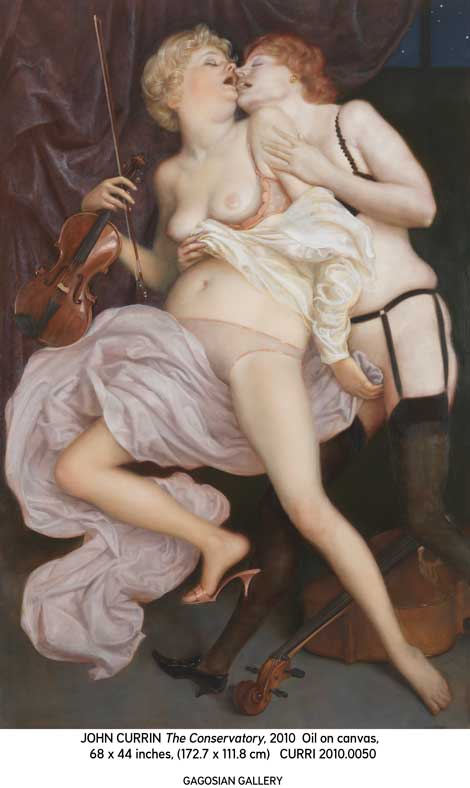It is difficult to imagine John Currin’s work adorning walls more modest than those of the uptown Gagosian Gallery in Manhattan. Currin’s subjects have become progressively more well-heeled as his career has advanced. His signature subjects of yore—the ludicrously big-titted women and the frail women in bed and the nymphettes clinging adoringly to wilting bearded aesthetes—are a thing of the distant past; he has now entered a sphere of affluence commensurate with the incomes of the select few who can afford to collect his paintings, which now sell in the million-dollar range. And why shortchange him? He is one of the most interesting painters around, justifiably extolled for his technique. There are other comparably gifted modern masters (Vincent Desiderio, Lisa Yuskavage), but none who ply their exquisitely wrought brushstrokes in the service of perversity quite as cleverly as Currin.
Though they do not comprise the bulk of his oeuvre, it is Currin’s depictions of the sex lives of the rich and complacent—in which porno-derived tropes of the Sapphic variety are transposed to upscale surroundings—that receive the most attention. The most prominent piece at the recent Gagosian show, The Women of Franklin Street, was a celebration of afternoon delight in which three upper-crust MILFs pictured in the throes of self-congratulatory sensuality, pleasure one another in a sumptuously appointed living room. Foliage rustles against a paneled window and an immaculately wrought tea set occupies the foreground. Another work in a similar vein, The Conservatory, features an erotically abandoned nocturnal music practice with plenty of middle-aged spread spilling out of black lace lingerie, and clitoral stimulation tastefully concealed by skillfully rendered folds of drapery. These paintings verge upon the grotesque; they are neither aesthetically inviting to the viewer nor sympathetic to the subject, but they are provocative and they hold one’s eye.
Women of a certain age have long been Currin’s special province. Women, as he put it in a well-circulated quote that got him into a lot of the right kind of trouble, “caught between the object of desire and the object of loathing.” Women like the graying dowager in The Old Fur, who opens a fur coat to reveal a “well-preserved” body, while taking a wistful sidelong glance. Many of Currin’s women sport these wistful expressions, as if casting a backward melancholy eye at the pleasures of their youth.
It is easy to imagine Currin smiling to himself as he works, tickled by the nervous laughter his subtly incorrect depictions of the cultured classes are likely to induce in the beholder. His stance of sardonic ambiguity makes people a little uneasy, but he never lays it on so thick—the paint or the premise—that one can tell exactly where he’s coming from. He never quite crosses the line into caricature, though he comes close with a painting called Hotpants, which resembles a Norman Rockwell composition. It’s the one work in the show that features men, if you can call them that. A gauzily-painted ponce in tight shorts primps in front of a full-length mirror, while a similarly attired tailor fusses over him. The absurd vanity—and vulnerability—of those whose wealth has inoculated them against reality is often captured by Currin, as in the treacly Dogwood Thieves, wherein two blithe blondes bedizened in sun hats, ribbons and flowers luxuriate in stolen moments, blissfully impervious to worldly concerns.
A different kind of awriness pervades each painting. They are all a little “off’’ in one way or another, enough to make one wonder what’s “going on.” In Flora, a diaphanously-negligéed blonde reclines over a basket of fruit while disappearing into the corner of the painting at an angle that throws the viewer off, while Big Hands appears to be a straightforward portrait of an attractive blonde, until one notices her thick masculine arms and hands. And what’s with the portrait of Constance Towers?
There are an abundance of blondes and strawberry blondes on display, but the brunettes steal the show. Here, with two paintings, Mademoiselle and The Reader, Currin further muddies the issue by playing it straight. With these simple renderings of women lost in seductive abstraction, he arrives at an arresting combination of classical portraiture and pinup art.
These works hark back to the days when portraiture was the domain of the aristocracy. Currin updates the tradition, eroticized and filled with art historical references. Whatever his position, nobody else does what he does, and the results are capable of reawakening one’s sense of wonder at what an artist is able to do by simply applying paint to canvas. Some dissenting voices might argue that such expertise in technique is wasted on frivolous subject matter, but there is no denying the power and originality of the work.



